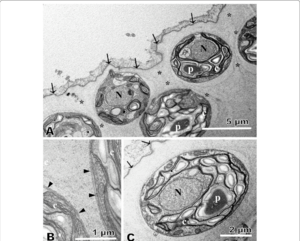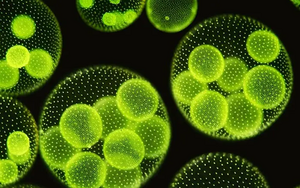Volvox africanus



Classification
Eukarya; Chlorophyta; Chlorophyceae; Chlamydomonadales; Volvocaceae
Species
Volvox africanus
NCBI: [1]
Description and Significance
Describe the appearance, habitat, etc. of the organism, and why you think it is important
Volvox africanus is a photosynthetic, multicellular eukaryotic microbe that lives in clusters. Volvox species exist as many cell colonies within a gelatinous barrier. They contain anywhere from several hundred to 6,000 cells within their gelatin bubble. In fact, the largest clusters are barely visible with the naked eye.
Volvox is a freshwater algal genus that was first discovered by Anton von Leeuwenhook in the 1700s.
Genome Structure
Describe the size and content of the genome. How many chromosomes? Circular or linear? Other interesting features? What is known about its sequence
This species has a haploid, linear genome, with 141 mb. The genome contains about 101 genes coding for 37,566 proteins.
Cell Structure, Metabolism, and Life Cycle
Interesting features of cell structure; how it gains energy; what important molecules it produces
Volvox shape is interesting since one volvox are many colonies within. The best way to describe it is a bunch of cocci unicellular organisms living within a spheritical gel-like substance. Each of cocci cells, called somatic cells, work together to survive. They have flagellum, eyespots, and vacuoles. The somatic cells move their flagellum in tandom for fast, coordinated directional movements.
It reproduces both asexually and sexually.
Ecology and Pathogenesis
Habitat; symbiosis; biogeochemical significance; contributions to environment.
If relevant, how does this organism cause disease? Human, animal, plant hosts? Virulence
factors, as well as patient symptom
Live in freshwaters sources. Like most algal species, occupy the surface of the water. Typically found in South Africa, other southern african countries, and south Asia.
All discovered volvox species are non-pathogenic.
References
https://en.wikipedia.org/wiki/Volvox https://utex.org/products/utex-lb-1890 https://www.ncbi.nlm.nih.gov/Taxonomy/Browser/wwwtax.cgi?id=51714 https://eol.org/pages/901574 https://www.algaebase.org/search/species/detail/?species_id=C60a996d47989b5be https://www.researchgate.net/figure/Transmission-electron-microscopy-of-asexual-spheroids-of-Volvox-africanus-GS-West_fig3_358009972 https://www.britannica.com/science/green-algae
Authors
Page authored by Hayden Hull, student of Professor Bradley Tolar at UNC Wilmington.
